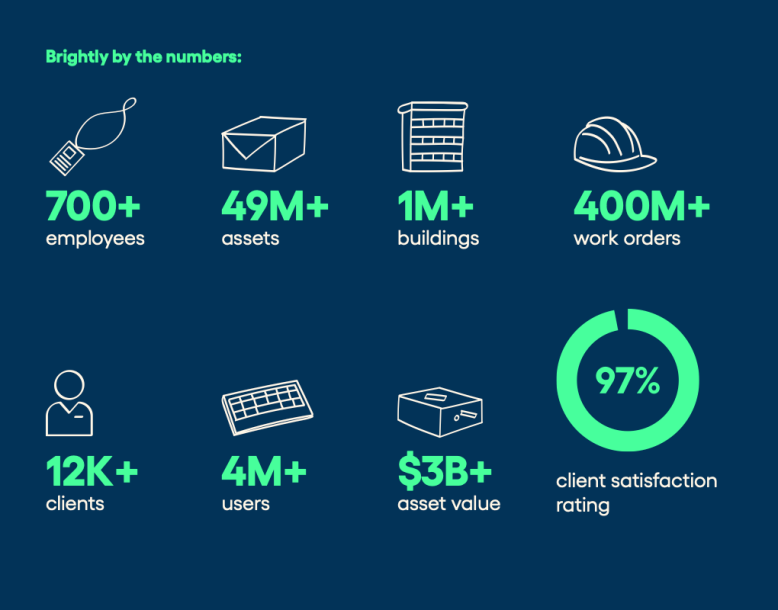3 steps to optimizing your operations
Get control and get ahead with these three steps to help you optimize your operations:
Step 1: Get the right help to achieve your goals
Get the support and tools you need to accomplish your operations goals
Step 2: Turn your data into decisions
Gain visibility into your work and utilize reporting to make more informed decisions.
Step 3: Streamline your workflows
Connect your operations to see the big picture of your work and plan for what’s ahead.
The operations industry has experienced significant change over the last 20 years – from paper-based work that moved slowly and provided little visibility, to SaaS-driven, cloud-based systems that offer more mobility and efficiency.
Today’s operations professionals rely on a mix of paper, desktop spreadsheets, SaaS systems, Internet of Things (IoT) and everything in between to manage their day-to-day, but which approaches are leading to success, and which are simply leading to survival?
If you’re like most operations leaders, you’ve likely been tasked with doing the impossible. You’re juggling work requests that never stop, unexpected repairs, attracting and retaining skilled employees, providing good customer service to those you serve – all with limited time and budget.
When you’re working in survival mode, reactively responding to the needs of today, how do you ever find the time or resources to plan for the future? How can you get to a place where you’re working several steps ahead, instead of always feeling behind?
If you feel like you’re putting in the work and still not meeting your goals, it’s likely your tools (or lack of) holding your operations back. Today’s technology has the power to streamline operations even further than you may realize, unlocking insights that can help organizations work smarter.
What’s important to know is that you don’t have to overhaul your processes overnight, and you don’t have to do it alone. You just have to be willing to take the next step. With these three proven steps to optimized operations, we’re here to help you get control and get ahead – for today and for the future.
Step 1: Get the right help to achieve your goals
Today’s operations have reached a point where your team cannot be successful without the right technology. If you or someone on your team or in your organization has been resistant to adopting the right operations software for your needs, what is that resistance to? Is it the investment, the implementation time, the training? Or maybe fear of change?
While those responses are normal, they don’t get you any closer to getting control of your operations. The right technology is arguably the wisest investment your organization canmake – leading to time saved, unnecessary expenses cut, increased job performance and satisfaction – but if you’re still hesitant about taking a step toward a complete operations suite, we’ve got you covered.
Brightly is not just a software provider, we’re a partner.
We’ve taken the first step with over 12,000 clients, and we continue walking with them every step after as they reach their goals. To put it bluntly, we’ve already ran into all the implementation issues for you.
After more than 20 years of serving the operations industry, we’ve navigated all the implementation roadblocks, figured out how to streamline training, and equipped our team with the right people and skills to ensure every client gets up and running as smoothly and quickly as possible.
No matter your starting point, we’ve seen it all, and we‘re here to help you get started. We’ve accumulated a lot of data – the largest and most complete bank of operations data in the industry. With that bank, we’re able to offer our own data story for clients to gain insights from to optimize their operations.
Our clients also gain insight from our community of their operations peers and our in-house experts. That’s over 12,000 organizations that have navigated similar challenges and can share valuable knowledge about how they’ve found solutions. It’s also 20 years of other organizations’ data you can leverage to understand how your industry is trending.
Bottom line?
Brightly is a trusted, strategic partner with unmatched industry expertise, community and resources to help your organization not just survive but thrive.
We know that first step isn’t always easy, but we’re here to take it with you. Our support isn’t called “legendary” for nothing.

Step 2: Turn your data into decisions
Did you get approval for that funding, project or new hire you requested? If not, it’s likely because your request lacked the necessary business justifications and data to back up your requests.
“Data” may sound like a scary word, something to be intimidated by. It sounds technical and complex, but you’re actually already collecting meaningful data every day. When you track how much you spent on a repair or log how many hours a work order required, that’s valuable data. And when you collect a lot of it, you can see how it comes together to tell a data story about your operations, like where your budget is going or what piece of equipment is becoming a drain on your team’s time.
Data gives you the visibility to make smarter decisions, and it acts as evidence when you make requests for resources. But that data needs to be reliable and easy to access, which isn’t likely to happen if you’re collecting it anywhere other than a secure, cloud-based CMMS (computerized maintenance management system) where it can’t be lost and isn’t spread out in different places.
When your whole team is tracking all their work (quality in, quality out) in one centralized system, that system will pull all the data together into meaningful reports you can access in an instant the next time you need to make an important decision or share numbers with your stakeholders.
What data can do for you:
• Deliver better service – Access data and technology to better serve your community and get your work done more efficiently.
• Analyze your operations – See where your time, money and resources are being spent so you can anticipate needs and make a case for more resources – or show where you’re excelling.
• Measure your performance – Define your goals by selecting from a pre-defined list of KPIs and measure and report on your performance.
Now, let’s take data a step further
So you’re collecting data, working more efficiently, making more informed decisions and communicating better with your organization. Your backlog is decreasing and you’re being more strategic with spending. You’re starting to get control of your day-to-day operations and can breathe a little easier.
Now, what if you could feel that kind of control and confidence not just about this year, but about years into the future?
Enter predictive operations, which is just a fancy way of saying you know what to do next, because you now have the key data and insights to help you look ahead proactively.
When you start working proactively, your team is able to get out of survival mode
In survival mode, you’re just thinking about getting through the day, week, month.
Your decisions are reactive and often based on what solves the problem for now.
But once you get control of your current operations, you have the ability to work proactively and set your organization up for success in the future.
Your data story begins acting like a roadmap, using what’s happened in the past to help you predict what’s coming so you can plan for it before it happens. For instance, if you’ve been logging work performed on a particular asset, you can use forecast reporting to predict that asset’s lifecycle. You’ll have a data-based idea about when it may break down, so you can make project priority decisions, proactively make the call on repairing versus replacing and include the expense in your capital planning.
When you wait until these breakdowns happen, you have to make game-time decisions that are often not what you would have chosen if you’d had time to plan. When you work proactively, you have that time, and your operations are all the better for it.
Your budget also benefits, because you’re able to use data to better predict when your assets actually need maintenance. So instead of waiting too long to perform maintenance and ending up with a costly asset breakdown, or performing maintenance too frequently and unnecessarily, you’re able to put your assets on the most beneficial maintenance schedule.
Simply put, working proactively shows you where you’ve been, where you are and where you’re going, so you’re prepared when you arrive.
Working proactively can help answer questions like:
• When is my HVAC unit likely to fail? • Should I repair or replace the roof?
• What workforce do I need for our future expected workload?
• How much will my operations likely cost over the next five years?
• How is my maintenance program impacting my capital spend?
Step 3: Streamline your workflows
If your maintenance team is like most others, you have an integral part to play in the success of other functions within your organization, like events and energy management. Say, for instance, that there’s an event coming up, hosted at your facility. While your organization’s Events team will handle the front end, it’s your team that will likely take care of setting up the event, any necessary tear-down, and custodial assistance during or after the event.
• Do you have a reliable way of tracking how much time or expense that labor is costing you so you can plan for it?
• Do you know the impact events are having on your facility?
• Is the process of requesting help from maintenance and getting confirmation it was handled easy for other departments and your team?
If not, you could benefit from connecting your operations.
That means integrating all your operations in one place so your systems can “talk” to one another, giving you a higher level of visibility, stronger data and increased efficiency.
When you connect your operations you can:
• Drive better communication and collaboration with other departments
• Remove guesswork and have answers to critical capital planning questions
• Provide enhanced service to your organization
• Get a complete view of your team’s impact and expected work
• Make a stronger case for the resources your team and organization needs
Connectedness gives your organization a seamless operations experience and a 360-degree view into how the parts affect the whole, as well as each other.
You have a reliable single source of truth on your operations, are able to feel more in control and can make more informed decisions about your operations.
Connected operations are a win-win for your entire organization
The departments you collaborate with can feel more in control, as well. When your operations are connected in a single system, that person in charge of events can create their own work order and see that their renter’s request was taken care of. This alignment closes the gap between departments and ensures the right people are doing the right job at the right time and place.

Taking the next step
Your choices this year determine how you’re able to operate next year and in years to come. What steps will you take now to optimize your operations for the future?
Working more proactively, seamlessly and with the data in hand to make decisions strategically, you’re guaranteed smarter operations, better communication, more job satisfaction for your team and informed capital planning you can be confident in.
Remember, you don’t have to optimize your operations all at once, and you don’t have to do it alone. Just take the first step and lay a foundation you can build upon at your own pace.
And if you know you need to make a change, but you’re not sure what that next step is, we have the experience and the support to help you figure it out so you can start taking real, meaningful action toward your goals.
When we talk about optimizing your operations, we’re talking about finding a better way to work. The right technology empowers you to do that, and so does Brightly.
So take the next step. Start by getting a free, no-obligation demo



